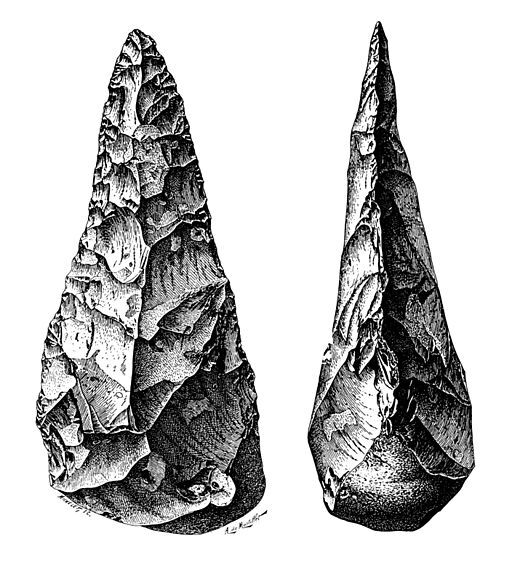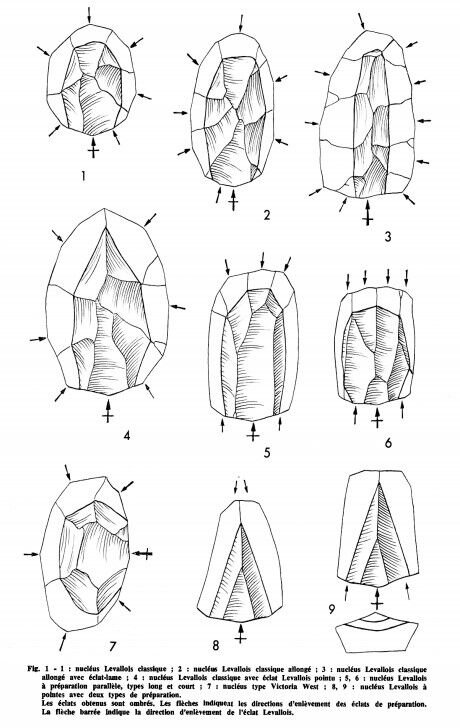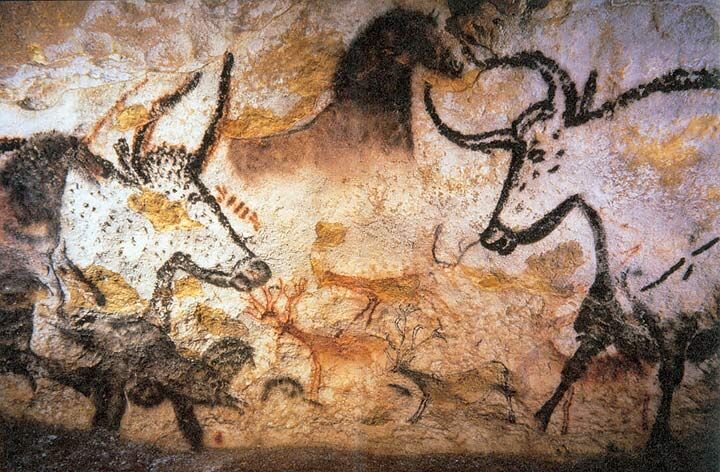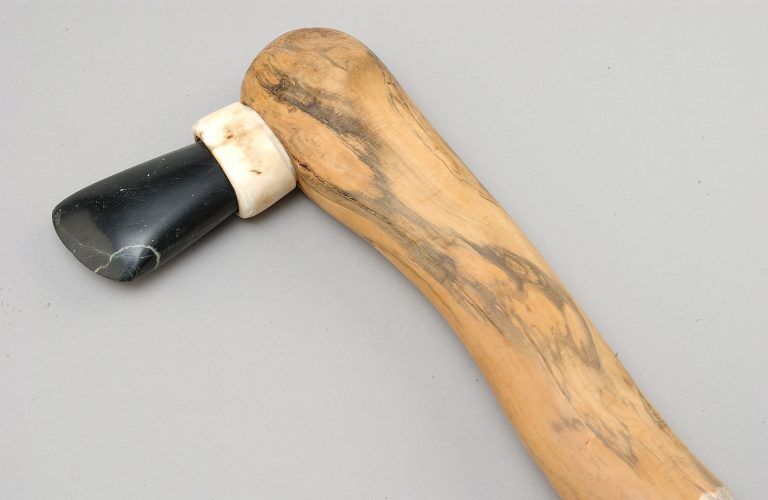The concepts covered in this fact sheet go beyond those taught in secondary school. It is intended as a supplement for students wishing to learn more.
Prehistory is divided into three periods:
Prehistory is generally defined as the period before the invention of writing. It begins with the appearance of humankind and ends with the beginnings of writing.
It is very difficult for palaeontologists to agree on a date for the appearance of the human race, since the information needed to do so is incomplete. Indeed, at any moment, a new discovery can shed new light on what specialists believe.
The timing of the appearance of humankind varies greatly depending on what is identified as its trigger:
-
the separation of the chimpanzee lineage from that of humans: 7 million years ago (Rauscher, E., 2020);
-
the appearance of the genus Homo: 2 million years ago (Rauscher, E., 2020);
-
Tool-making: 3.3 million years ago (Hominidae, 2015).
A majority of experts agree that the human race first appeared 7 million years ago. (Rauscher, E., 2020).
The term Homo refers to the human genus, including the species Homo sapiens, Homo erectus, Homo habilis and others.
The Paleolithic, which means Ancient Stone Age, is the first period of prehistory. It began with the appearance of humankind and ended at different times in different parts of the world.
Depending on the expert, the Paleolithic period is divided into three or four sub-periods.
In the Paleolithic, human beings were nomadic. They lived by hunting and foraging or gathering, travelling in clans or tribes. They were defined as "hunter-gatherers".
During the Paleolithic period, the genus Homo evolved intoHomo sapiens, which means "intelligent being". Their first traces date back around 300,000 years, but they were not alone (Mayer, 2017). During the Paleolithic, a species close toHomo sapiens lived at the same time: Neanderthal man. This species disappeared 30,000 years ago (Labelle, 2019). All modern men and women are Homo sapiens, regardless of the region they live in or the colour of their skin.
Although our species is Homo sapiens, modern humans have a small percentage of DNA from Homo neandertalensis (Neanderthal man). If you'd like to find out more about the cross between Homo sapiens and Neanderthal, read the article Why did Neanderthals disappear and we didn't?
This period is not recognised by all palaeontologists, with some including it in the Lower Paleolithic. What's more, its beginning, which also marks the start of prehistory, can vary because of what is considered to be the appearance of the human race. Australopithecus lived partly during the Archaic Paleolithic. This species is considered to be the first biped. This period ended when humans began to use a tool known as the biface.
A biped is a creature that moves on two feet.
In the Lower Paleolithic, humans used carved stone tools such as the biface, in particular to cut the flesh of their prey. It was also during this period that Homo erectus mastered fire (Larané, 2020).

Source : Biface silex [Dessin], De Mortillet, A., fin du 19e siècle, Wikimedia commons, (URL). CC0 1.0.
In the Middle Paleolithic, humans increasingly used chipped stones and less bifaces, until they stopped using bifaces. The flaked stone technique, which was developing, made it possible to manufacture a specific tool and use the other small flakes created during manufacture. The flaked stone technique requires more thought than making a biface. Depending on the intended use, the shape of the flake will not be the same. Some of the splinters produced are used at the end of wooden sticks to make spears. This made it easier to hunt large animals. Neanderthals, who lived during the Middle Paleolithic, hunted mammals such as bison, saiga and reindeer.
This period is marked by the first traces of spirituality, revealed by the discovery of human burial sites, as well as by the presence of aesthetic elements such as engravings on bones that would have been used as jewellery.

The image shows chips obtained using a technique now known as Levallois. The final chips, i.e. the pieces that are used for different tasks, are shaded in the image. To obtain these, other splinters have to be removed. The arrows show the direction of the blows that need to be made to remove these different splinters. The crossed-out arrow indicates the last blow that removes the final chip that is used as a tool.
Source : Bordes, 1980
A burial site is the place where the body of a deceased person is laid to rest.
In the Upper Paleolithic, human beings perfected their skills and made increasingly specialised tools to accomplish different tasks. The materials used to make these tools became more varied. They could be made of flint, bone or ivory. It was during this long period that the eye needle was used for the first time to sew animal skins into clothing.
An eye is the hole in a needle through which the thread is threaded.
As far as art is concerned, traces of artistic creations dating back to the Upper Paleolithic have been found in various places, including the Lascaux cave.

Animal paintings in the Lascaux cave in France.
Source : Aurochs, Horses and Deer [Peinture], Prof saxx, février 2006, Wikimedia commons, (URL). CC BY-SA 3.0.
The Mesolithic means the middle of the Stone Age and corresponds to the period between the Paleolithic (Old Stone Age) and the Neolithic (New Stone Age).
This is considered to be a transitional period between the Paleolithic, when human beings lived mainly from hunting and gathering, and the Neolithic, when they began to adopt agriculture and livestock farming.
During the Mesolithic period, the climate was generally much warmer and the fauna changed. Some animals, including mammoths, disappeared. Others, such as reindeer, were hunted northwards by the heat. A temperate climate fauna developed in Europe and South-East Asia (deer, horses, wild boar, etc.).
Mesolithic people developed smaller but sharper hunting tools, such as arrowheads. The bow and arrow seems to have been the most commonly used weapon during this period. Fishing also developed with the use of a new instrument, the chisel, which enabled hooks to be carved from bone. In addition, the manufacture of nets, wooden harpoons, harpoons with stone points and leather straps made fishing more practical.
The Neolithic period is also known as the Age of the New Stone, in reference to the first polished stones (shiny and soft) worked by human beings.
This important period marked a profound break in the organisation of human society: some people living in the Neolithic period continued to live off hunting and gathering as nomads, but what differed from previous periods was that other people began to produce their own food. They did this by mastering the techniques of agriculture and livestock farming. These two ways of life coexisted throughout the Neolithic period. This period was therefore a transition from a lifestyle based on hunting and gathering to one based on agriculture and livestock farming.
Several communities began raising animals such as sheep, goats and pigs. They also began farming, planting cereals such as wheat and barley. Some people in the community specialise in handicrafts, making pottery or weaving clothes or ropes. Others developed the art of polishing certain stones, such as polished axes.

‘Reconstruction of an axe with its wooden handle and deer antler sheath’ (Musée Fenaille, n.d.)
Source : Haches polies [Photographie], musée Fenaille, s.d. (URL). Droits réservés*
Groups chose a territory and settled there. It was largely because of agriculture, which required people to stay in one place for several months to harvest grain, that these groups chose a sedentary lifestyle. It was then that they developed the construction of more durable shelters. These shelters partly define their sedentary lifestyle, i.e. having a fixed place to live and no longer having to travel to find food.
Although human groups did not begin farming and livestock farming everywhere at the same time, experts agree that the transition began in the Near East, more specifically in the Fertile Crescent.
Bordes, F. (1980). Le débitage Levallois et ses variantes. Bulletin de la Société préhistorique française, 77(2), 45-49. https://www.persee.fr/doc/bspf_0249-7638_1980_num_77_2_5242
De Mortillet, A. Biface silex [Dessin]. (Fin du 19e siècle). Wikimedia commons. https://commons.wikimedia.org/wiki/File:Biface.jpg
Hominidés. (2015, 21 mai). Les premiers outils âgés de 3,3 millions d’années?. https://www.hominides.com/html/actualites/premiers-outils-3-3-millions-annees-925.php
Labelle, A. (2019, 18 juin). L’héritage génétique de l’homme de Néandertal se précise. Radio-Canada. https://ici.radio-canada.ca/nouvelle/1060582/homme-neandertal-genome-genes-humains
Larané, A. (2020, 26 aout). Paléolithique inférieur — Aux origines de l’humanité. Hérodote. https://www.herodote.net/Aux_origines_de_l_humanite-synthese-164.php
Mayer, N. (2017, 8 juin). Homo sapiens : l’Homme aurait 100.000 ans de plus qu’on ne le pensait. FuturaSciences. https://www.futura-sciences.com/sciences/actualites/homme-homo-sapiens-homme-aurait-100000-ans-plus-quon-ne-pensait-27053/
Musée Fenaille. (s.d.). Haches polies [Photographie]. https://musee-fenaille.rodezagglo.fr/chefs-doeuvres/haches-polies/ *Extrait employé par Alloprof conformément à la Loi sur le droit d'auteur dans le cadre d'une utilisation équitable aux fins d’éducation [https://laws-lois.justice.gc.ca/fra/lois/c-42/page-9.html].
Prof saxx. (Février 2006). Aurochs, Horses and Deer [Peinture]. Wikimedia commons. https://commons.wikimedia.org/wiki/File:Lascaux_painting.jpg
Rauscher, E. (2020, 27 décembre). Quand l’homme est-il apparu?. Science&Vie. https://www.science-et-vie.com/questions-reponses/d-ou-vient-l-homme-7817